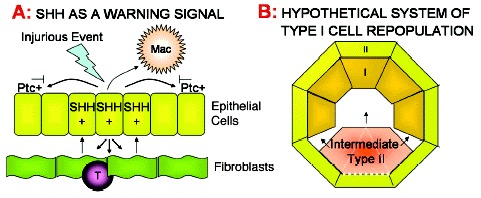From: Shh Expression in Pulmonary Injury and Disease

NCBI Bookshelf. A service of the National Library of Medicine, National Institutes of Health.

A) Epithelial cell Shh has the potential to signal to neighboring cells to warn of cellular injury, and generate matrix deposition and proliferation in underlying fibroblasts, preventing transudation in the event of epithelial shedding. Communication with Macrophage and T lymphocytes is also possible, as is fibroblast-epithelial signaling. B) Type II cells are restricted to junctional positions at the entrance to alveoli, as shown this aerial diagram. In the event of type I cell loss, type II cells form intermediate cells which differentiate and spread into type I cells. Shh upregulation may represent a differentiation inhibitor, to which cells adjacent to denuded areas are nonresponsive.
From: Shh Expression in Pulmonary Injury and Disease

NCBI Bookshelf. A service of the National Library of Medicine, National Institutes of Health.